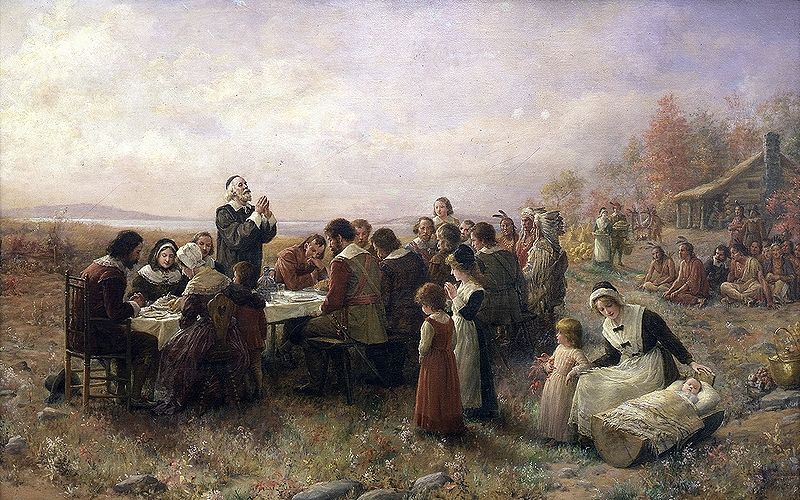With Thanksgiving approaching, elementary school-aged children in the United States are preparing to play yams in school plays, in which they may also sing songs about pumpkin pie and cranberries. They will dress up as Pilgrims with black hats and large, shiny buckles. And they may mime a feast with Native Americans, signifying the beginning of a tradition of giving thanks in November. Their parents will undoubtedly be delighted—as they should be: every child needs a picture dressed as a yam.
These elements of Thanksgiving that will be put on display are the same half-truths that I was taught as a child. Of course, it's not as though it's an intentional effort to mislead the public about the holiday, but Thanksgiving is a constructed holiday—over the years we have pieced together history and popular customs to create this national festival. It is based on a feast of thanksgiving, which was a religious event, where the celebrants give thanks to their god(s). Many different people have marked this occurrence. The tradition of giving thanks after a good harvest year, for example, was marked by the Celts—giving us Samhain and ultimately Halloween. In North America, the Pueblo, Cherokee, Creek, and others held harvest festivals. So the practice wasn't unique to the early settlers at Plymouth. In fact, Thanksgiving was not declared a national holiday until Lincoln's proclamation in 1863—commissioning a Thanksgiving observance on the last Thursday in November. Prior to this, states held their own thanksgiving festivals, and they weren't always in the fall. In 1941, President Roosevelt signed a bill into law setting Thanksgiving as the third Thursday in November. The move was calculated to help retailers combat the Depression with a longer holiday sales period.
[Image Above: "The First Thanksgiving at Plymouth" (1914) By Jennie A. Brownscombe.]
While the 1621 celebration at Plymouth has long been regarded as the first Thanksgiving, historians now know that in 1619, the settlers at the Berkeley Plantation held a mass of thanksgiving to mark their safe arrival at the settlement. Other half-truths that have survived include:
- The Pilgrims made pumpkin pie (this recipe didn't exist at this point); had ham (no evidence suggests that pigs were butchered at this point); and ate yams (which were uncommon). More on the original Thanksgiving menu here.
- The Pilgrims only wore black clothing, with buckles. In truth, black and white were for Sundays and formal occasions and buckles did not come into fashion until late in the 17th-century.
- The Pilgrims and the Native Americans had
 a dignified meal where they displayed impeccable table manners. Actually, no one used plates or silverware. Instead, they used a cloth napkin to handle hot pieces of food, which was likely just set out on every available surface, including tree stumps, and eaten over three days. The image of a perfect family meal is purely constructed—it was probably a bit more chaotic (like most of our Thanksgivings). [Image Right: Saying grace before carving the turkey at Thanksgiving dinner in the home of Earle Landis in Neffsville, Pennsylvania c. 1942. Public domain.]
a dignified meal where they displayed impeccable table manners. Actually, no one used plates or silverware. Instead, they used a cloth napkin to handle hot pieces of food, which was likely just set out on every available surface, including tree stumps, and eaten over three days. The image of a perfect family meal is purely constructed—it was probably a bit more chaotic (like most of our Thanksgivings). [Image Right: Saying grace before carving the turkey at Thanksgiving dinner in the home of Earle Landis in Neffsville, Pennsylvania c. 1942. Public domain.]
So who cares? What does it matter if we teach our children that the Pilgrims at Plymouth Rock ate pumpkin pie and had cranberry sauce? That they wore funny black hats? These half-truths come to make up our national history. And while it can be difficult for facts to survive the ravages of time, new technologies and methods have made it possible to us to piece together the artifacts we find to paint a picture of the past—an accurate picture. New technologies and methods have made it possible for us to understand what the landscape looked like when early settlers arrived, and how they would have interacted with the land. This information helps us better understand our history as a people and our tendencies as a nation.
In this spirit, I am dedicating this week's blog entries to history that has survived—history that is around us, that has shaped us, that we walk by everyday without seeing. And I dedicate it to diversity. Thanksgiving in the United States is marked by people from different cultures and religions; it is a time to come together. I hope you'll enjoy these excursions with me.
Were you ever a dancing yam? What does Thanksgiving mean to you? Share your stories below. Also, if you're interested, you can read a rebuttal of the Thanksgiving "debunkers" here.


No comments:
Post a Comment